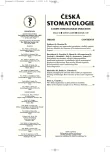Effect of the Implant Length on its Primary Stability
Authors:
L. Dzan
; L. Čapek 1
Authors‘ workplace:
Oddělení ústní, čelistní a obličejové chirurgie KN Liberec, a. s.
; Katedra mechaniky, pružnosti a pevnosti, Fakulta strojní, Technická univerzita Liberec
1
Published in:
Česká stomatologie / Praktické zubní lékařství, ročník 109, 2009, 3, s. 58-62
Overview
Dental implantology is one of the fastest developing areas of stomatology. An implantologists needs to have good quality medically proven information so that they can provide the best care for the patience from what today’s science and market offers. Long term correct functioning of the implants is influenced by their design (size, surface, diameter and length) and surgical procedure of the implantation. The subject of this work is the evaluation of the influence of the length of the implant on its primary stability measured by Resonance Frequency Analysis (RFA) and a resulting set of parametric calculations with using the method of the sinite elements.
Key words:
implant design - Resonance Frequency Analysis (RFA) - finite element analysis - implant length
Sources
1. Al-Nawas, B., Groetz, K. A., Goetz, H., Duschner, H., Wagner, W.: Comparative histomorphometry and resonance frequency analysis of implants with moderately rough surfaces in a loaded animal model. Clin. Oral Impl. Res., 19, 2008, s. 1-8.
2. Cawley P., Pavlakovic B., Alleyne D. N., George R., Back T., Meredith N.: The design of a vibration transducer to monitor the integrity of dental implants. Proc. Instn. Mech. Engrs., 212, 1998, s. 265-272.
3. DeTolla, D. H, Andreina, S., Patra, A., Bujíte, R., Comella, B.: The role of the finite element model in dental implants. J. Oral Implantol., 26, 2000, 2, s. 77-81.
4. Ito, Y., Sato, D., Yoneda, S., Ito, D., Kondo, H., Kasugai, S.: Relevance of resolnance frequency analysis to evaluate dental implant stability: simulation and histomorphometrical animal experiments. Clin. Oral Impl. Res., 19, 2008, s. 9-11.
5. Lachmann, S., Jäger, B., Axmann, D., Gomez-Roman, G., Groten, M., Weber, H.: Resonance frequency analysis and damping capacity assessment. Part I: an in vitro study on measurement reliability and a method of comparison in the determination of primary dental implant stability. Clinical Oral Implants Research, 17, 2006, s. 75- 79.
6. Lachmann, S., Laval, J. Y., Jäger, B., Axmann, D., Gomez-Roman, G., Groten, M., Weber, H.: Resonance frequency analysis and damping capacity assessment. Part II: peri-implant bone loss follow-up. An in vitro study with periost and osstell instruments. Clinical Oral Implants Research, 17, 2006, s. 80-84.
7. Meredith, N., Allene, D., Cawley, P. Quantitative determination of the stability of the implant-tissue interface using resonance frequency analysis. Clinical Oral Implants research, 1996, 7, s. 261-267.
8. Meredith, N., Book, K., Friberg, B., Jemt, T., Sennerby, L.: Resonance frequency measurements of implant stability in vivo. A cross-sectional and longitudinal study of resonance frequency measurements on implants in the edentulous and partially dentate maxilla. Clin. Oral Impl. Res., 8, 1997, s. 226-233.
9. Meredith, N., Shagaldi, F., Allene, D., Sennerby, L., Cawley, P.: The application of resonance frequency measurements to study the stability of titanium implants during healing in the rabbit tibia. Clin. Oral Impl. Res., 8, 1997, s. 234-243.
10. Mihoko A. el at.: Methods used to assess implant stability: current status. Oral and Maxillofacial Surgery, 22, 2007, s. 743-754.
11. OsstellTM Mentor user‘s manuals. Integration Diagnostics AB, Goteborg.
12. OsstellTM user‘s manual. Integration Diagnostics AB, Goteborg.
13. Pattijn, V., Jaecques. S. V. N., De Smet, E., Muraru, L., Van Lierde, C., Van der Perre, G., Haert, I., Vander Sloten, J.: Resonance frequency analysis of implants in the guinea pig model: Influence of boundary conditions and orientation of the transducer. Medical Engineering & Physics, 29, 2007, s. 182-190.
14. Pattijn, V., Lierde, C., Perre, G., Naert, I., Sloten, J.: The resonance frequencies and mode shapes of dental implants: Rigid body behaviour versus bending behaviour. A numerical approach. Journal of Biomechanics, 39, 2006, s. 939-947.
15. Samiotis, A., Batniji, M., Lopez, L., Steveling, H.: Clinical monitoring with RFA of astra implants. Poster J. Dent. Oral Med., 2003, 5, Poster 203.
16. Sjőstrőm, M., Lundgren, S., Nilson, H., Sennerby, L. Monitoring of implant stability in grafted bone using resonance frequency analysis. A clinical study from placement to 6 months of loading. Oral and Maxillofacial Surgery, 34, 2004, s. 45-51.
17. Veltri, M., Balleri, P., Ferrari, M.: Influence of transducer orientation on OsstellTM stability measurements of osseointegrated implants. Clin. Impl. Dent. Rel. Res., 9, 2007, s. 60-63.
Labels
Maxillofacial surgery Orthodontics Dental medicineArticle was published in
Czech Dental Journal

2009 Issue 3
- What Effect Can Be Expected from Limosilactobacillus reuteri in Mucositis and Peri-Implantitis?
- The Importance of Limosilactobacillus reuteri in Administration to Diabetics with Gingivitis
Most read in this issue
- Papillon-Lefevre Syndrome
- Healing of Pathologic Bone Cavities of Jaws after Augmentation
- Tooth Autotransplantation. A Review
- Salivary Markers for Diseases of Periodontium and other Organs
